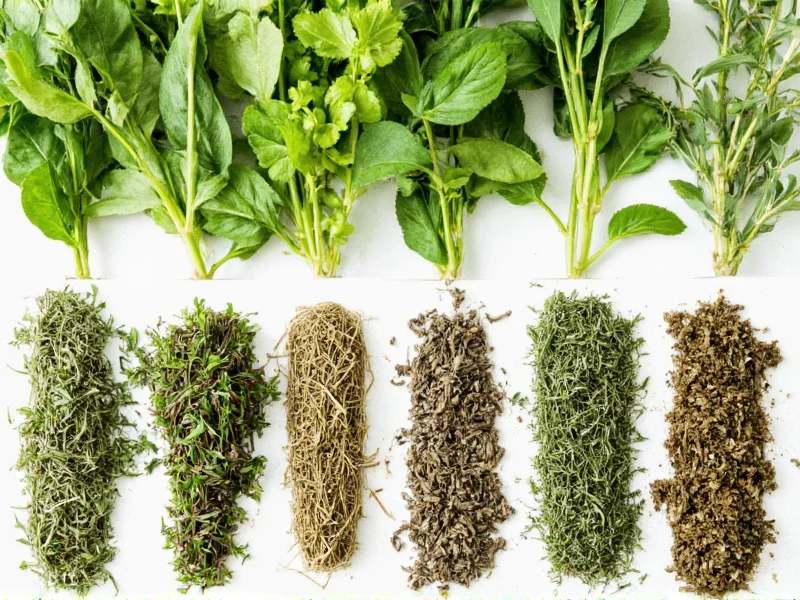Many home cooks mistakenly believe dried herbs can be transformed back into fresh. This fundamental misunderstanding stems from confusing substitution with conversion. Once herbs undergo the drying process, their cellular structure changes permanently. The moisture loss concentrates flavors but eliminates the crisp texture and volatile oils that characterize fresh herbs. No rehydration method restores herbs to their original state.
Understanding Herb Substitution Ratios
The critical knowledge home chefs need isn't conversion but proper substitution measurements. Dried herbs contain approximately three times the flavor concentration of fresh herbs due to water removal. This concentration affects both measurement and timing in cooking:
| Fresh Herb Measurement | Dried Herb Equivalent | Best Usage Timing |
|---|---|---|
| 1 tablespoon fresh | 1 teaspoon dried | Add dried herbs early in cooking |
| 1 teaspoon fresh | ¼ teaspoon dried | Add dried herbs early in cooking |
| ¼ cup fresh | 1½ teaspoons dried | Add dried herbs early in cooking |
| 1 cup fresh (chopped) | 3 tablespoons dried | Add dried herbs early in cooking |
When Fresh and Dried Herbs Shine
Certain culinary applications favor one form over the other. Understanding these differences helps maximize flavor in your dishes:
Fresh Herb Advantages
- Delicate dishes like salads, garnishes, and finishing touches
- Ceviche and other raw preparations
- When visual presentation matters
- Recipes requiring bright, grassy notes (like pesto)
Dried Herb Strengths
- Long-simmered dishes (stews, soups, braises)
- Dry rubs and spice blends
- Baking applications (like herb breads)
- When consistent flavor concentration is critical
Maximizing Dried Herb Flavor
While you can't convert dried herbs to fresh, you can optimize their performance:
- Bloom in oil or liquid: Heat dried herbs in cooking oil or broth for 1-2 minutes before adding other ingredients. This releases essential oils.
- Grind before use: Crush dried herbs between your palms or with a mortar and pestle to break cell walls and release flavors.
- Store properly: Keep dried herbs in airtight containers away from light and heat. Most retain peak flavor for 6-12 months.
- Adjust for age: Older dried herbs lose potency. Increase quantity by 25% for herbs stored longer than 6 months.
Proper Drying Technique for Fresh Herbs
Since converting dried to fresh isn't possible, focus on proper drying methods when preserving your garden harvest:
- Harvest herbs in morning after dew evaporates
- Wash gently and pat completely dry
- Air dry in small bundles upside down in dark, well-ventilated area
- Alternatively, use food dehydrator at 95°F (35°C) until brittle
- Store dried herbs whole until ready to use
Understanding dried herbs to fresh conversion ratios prevents recipe disasters. Many cooking failures occur when home chefs use equal measurements of dried and fresh herbs. Remember that dried oregano, thyme, and rosemary particularly benefit from the 3:1 substitution ratio, while more delicate herbs like basil and cilantro show greater flavor loss when dried.
Frequently Asked Questions
Can I rehydrate dried herbs to use as fresh?
No, rehydrating dried herbs only restores some moisture but cannot recreate the cellular structure, volatile oils, or texture of fresh herbs. Rehydrated dried herbs become mushy and lack the bright flavor profile of fresh varieties.
Why do recipes specify fresh or dried herbs?
Recipes specify herb forms because they behave differently in cooking. Fresh herbs provide bright top notes best added late in cooking, while dried herbs need time to rehydrate and release flavors, making them ideal for long-simmered dishes. Substituting without adjusting measurements alters flavor balance.
Which herbs convert best from fresh to dried?
Hardy herbs like rosemary, thyme, oregano, and sage retain the most flavor when dried. Delicate herbs like basil, cilantro, and dill lose significant flavor and texture during drying. For best results, use hardy herbs dried and delicate herbs fresh.
How do I adjust recipes calling for fresh herbs when I only have dried?
Use one-third the amount of dried herbs compared to fresh. For example, if a recipe calls for 3 tablespoons fresh basil, use 1 tablespoon dried basil. Add dried herbs earlier in cooking to allow time for flavor release, and consider blooming them in oil first for maximum flavor extraction.











 浙公网安备
33010002000092号
浙公网安备
33010002000092号 浙B2-20120091-4
浙B2-20120091-4